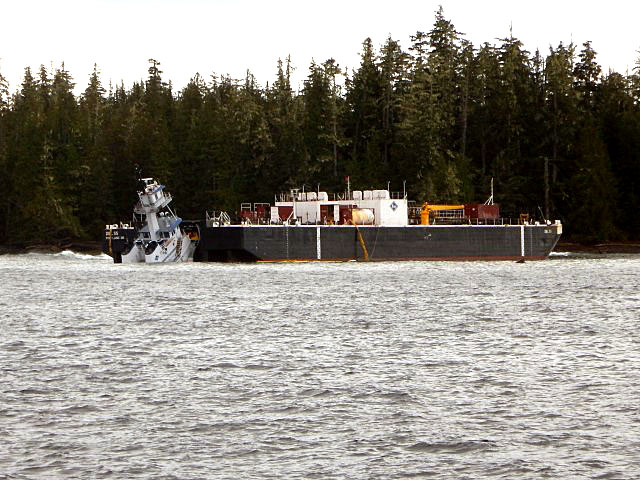Grounding and subsequent sinking
Articulated tug-barge
Tug Nathan E. Stewart and tank barge DBL 55
Seaforth Channel, 10 nm west of
Bella Bella, British Columbia
The occurrence
On 13 October 2016, shortly after 0100 Pacific Daylight Time, the articulated tug-barge composed of the tug Nathan E. Stewart and the tank barge DBL 55 went aground on Edge Reef near Athlone Island, at the entrance to Seaforth Channel, approximately 10 nautical miles west of Bella Bella, British Columbia. The tug's hull was eventually breached and approximately 110 000 L of diesel oil were released into the environment. The tug subsequently sank and separated from the barge. The tug was removed from the environment 33 days after the occurrence. Seven 208 L drums of diesel oil–soiled absorbent pads were collected from the site.
Safety communications
Recommendations
TSB Recommendation M18-01: the Department of Transport require that watchkeepers whose work and rest periods are regulated by the Marine Personnel Regulations receive practical fatigue education and awareness training in order to help identify and prevent the risks of fatigue
TSB Recommendation M18-02: the Department of Transport require vessel owners whose watchkeepers' work and rest periods are regulated by the Marine Personnel Regulations to implement a comprehensive fatigue management plan tailored specifically for their operation, to reduce the risk of fatigue.
Media materials
News release
TSB issues new recommendations to reduce the risk of fatigue in the marine industry
Read the news release
Backgrounders
Investigation findings (M16P0378) 2016 grounding and sinking of the Nathan E. Stewart
Read the backgrounder
Response to the grounding and sinking of the Nathan E. Stewart – Roles and responsibilities (M16P0378)
Read the backgrounder
Fatigue in the marine industry: risk factors, mitigation strategies and fatigue management
Read the backgrounder
New and previous TSB recommendations to address the risk of fatigue in the marine sector
Read the backgrounder
Speeches
News conference forthe release of the Marine Investigation Report M16P0378 (Nathan E. Stewart) – Opening remarks
Read the speech
Kathy Fox, TSB Chair
Media advisory
TSB to hold a news conference to release its investigation report into the October 2016 grounding and subsequent sinking of the tug Nathan E. Stewart near Bella Bella, British Columbia
Read the media advisory
Deployment notice
TSB launches investigation into the grounding of the tug Nathan E. Stewart and tanker barge DBL 55 in Seaforth Channel, British Columbia
Richmond, British Columbia, 24 October 2016 — The Transportation Safety Board of Canada (TSB) has launched an investigation into the grounding of the tug Nathan E. Stewart while pushing the barge DBL 55 in Seaforth Channel, British Columbia that occurred on October 13.
TSB looks into the grounding of the tug Nathan E. Stewart
Richmond, British Columbia, 17 October 2016 — The Transportation Safety Board of Canada (TSB) is following up on the grounding of the Nathan E. Stewart in Seaforth Channel, British Columbia. The TSB is gathering information and will conduct interviews with the crew of the vessel as it continues to assess the occurrence.
Investigation information
Download high-resolution photos from the TSB Flickr page.
Class of investigation
This is a class 2 investigation. These investigations are complex and involve several safety issues requiring in-depth analysis. Class 2 investigations, which frequently result in recommendations, are generally completed within 600 days. For more information, see the Policy on Occurrence Classification.
TSB investigation process
There are 3 phases to a TSB investigation
- Field phase: a team of investigators examines the occurrence site and wreckage, interviews witnesses and collects pertinent information.
- Examination and analysis phase: the TSB reviews pertinent records, tests components of the wreckage in the lab, determines the sequence of events and identifies safety deficiencies. When safety deficiencies are suspected or confirmed, the TSB advises the appropriate authority without waiting until publication of the final report.
- Report phase: a confidential draft report is approved by the Board and sent to persons and corporations who are directly concerned by the report. They then have the opportunity to dispute or correct information they believe to be incorrect. The Board considers all representations before approving the final report, which is subsequently released to the public.
For more information, see our Investigation process page.
The TSB is an independent agency that investigates air, marine, pipeline, and rail transportation occurrences. Its sole aim is the advancement of transportation safety. It is not the function of the Board to assign fault or determine civil or criminal liability.

